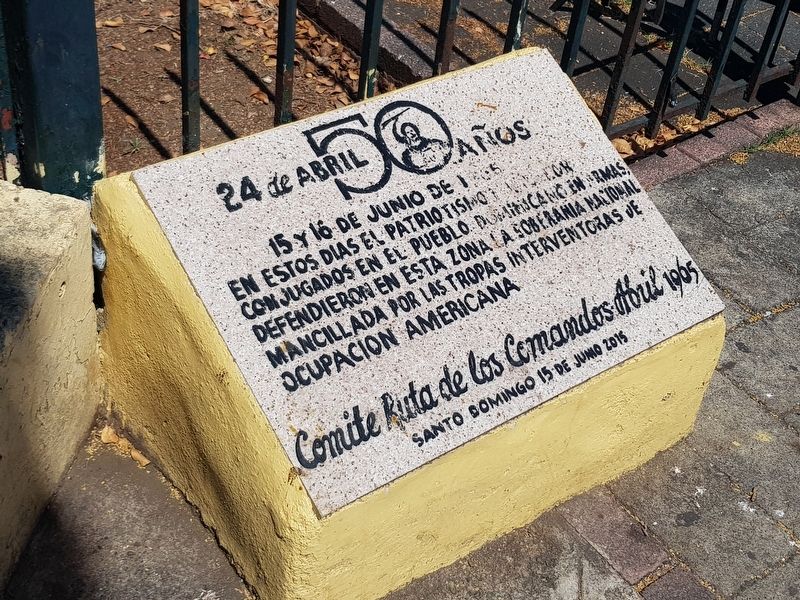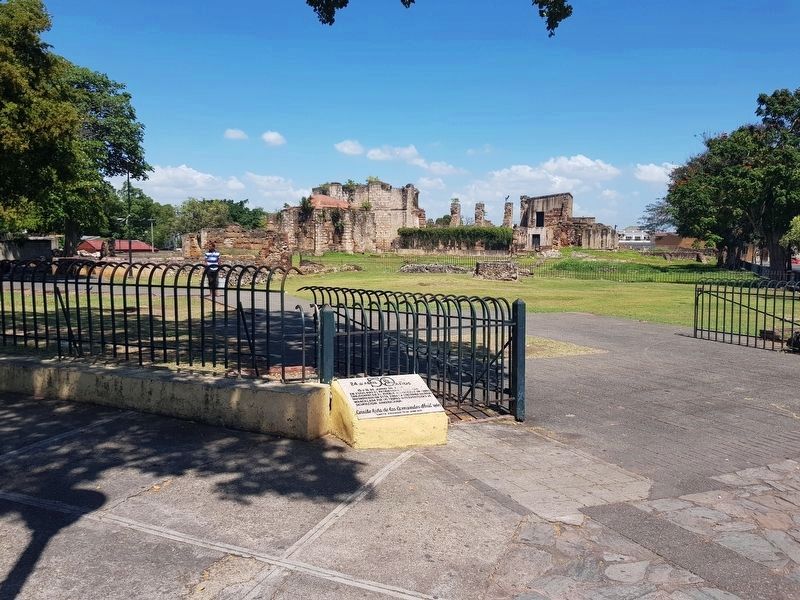San Antón in Santo Domingo, Distrito Nacional, Dominican Republic — Caribbean Region of the Americas (Hispaniola, Greater Antilles, West Indies)
Dominican Resistance to the US Invasion of 1965
Inscription.
15 y 16 de junio de 1965
En estos días el patriotismo y emoción conjugados en el pueblo dominicano en armas, defendieron en esta zona la soberanía nacional mancillada por las tropas interventoras de ocupación americana
Comité Ruta de los Comandos Abril 1965
Santo Domingo 15 de junio 2015
50th Anniversary of the April 24th Uprising
June 15-16, 1965
On these days, patriotism and emotion combined in the armed Dominican people, when they defended here the national sovereignty that had been stained by the invading troops of the American occupation
Committee for the Comandos Route of April 1965
Santo Domingo, June 15, 2015
Erected 2015 by Comité Ruta de los Comandos Abril 1965.
Topics. This memorial is listed in this topic list: Military.
Location. 18° 28.57′ N, 69° 53.204′ W. Marker is in San Antón, Distrito Nacional, in Santo Domingo. Memorial is at the intersection of Calle Duarte and Calle Juan Isidro Pérez, on the left when traveling south on Calle Duarte. Touch for map. Marker is at or near this postal address: Calle Duarte 270, San Antón, Distrito Nacional 10211, Dominican Republic. Touch for directions.
Other nearby markers. At least 8 other markers are within walking distance of this marker. José Martí in Santo Domingo (about 120 meters away, measured in a direct line); Monument of the San Francisco Ruins (about 150 meters away); Santa Maria, Virgin of Altagracia (about 150 meters away); Ruins of the Temple and Hospital of San Nicolas de Bari (about 180 meters away); The House of the Five Medallions (about 180 meters away); The Church of Saint Michael (about 180 meters away); House of Marcelo de Villalobos (about 210 meters away); Hospital San Nicolas de Bari (about 210 meters away).
Regarding Dominican Resistance to the US Invasion of 1965. The Dominican Civil War occurred from April 24 to September 3, 1965, in Santo Domingo, the Dominican Republic. It started when civilian and military supporters of the constitutionally elected former president Juan Bosch, overthrew the acting President Donald Reid Cabral. This prompted General Elías Wessin y Wessin to organize elements of the military loyal to acting President Reid (Loyalists), initiating an armed campaign against the Constitutionalist rebels. Allegations of foreign support for the Constitutionalists led to
an American intervention into the conflict, which later transformed into a Organization of American States occupation of the country. Elections were finally held in 1966, where Joaquín Balaguer was elected president. Later in the same year international troops departed from the country.
More than 23,000 U.S. troops landed in Santo Domingo, the Dominican capital, to stop what it believed was a communist insurgency there. The action was heavily criticized because President Johnson was seen to have exaggerated the threat of outside communists in what was a civil conflict. When violence erupted in Santo Domingo, hundreds of U.S. paratroopers landed quickly to protect foreigners. A few days later, tens of thousands more joined them. Although that unmatchable firepower put a stop to any resistance that might have caused U.S. casualties, it also separated the warring Dominican factions and probably ultimately saved Dominican lives.
Credits. This page was last revised on March 3, 2023. It was originally submitted on March 11, 2018, by J. Makali Bruton of Accra, Ghana. This page has been viewed 289 times since then and 18 times this year. Photos: 1, 2. submitted on March 11, 2018, by J. Makali Bruton of Accra, Ghana.

